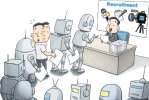1 . After decades of playing catch-up with the U.S. and Russian space programs, China did something neither nation nor any other had done this December: land a spaceship on the dark side of the moon.
Strictly speaking, of course, the moon has no dark side. But because of the way it orbits Earth, our natural satellite shows us only one side - the other is hidden from our view. No one even saw the far side until 1959, when the Soviet Luna 3 spaceship flew around for a look and sent back photos. No astronaut or spaceship went there until this December, when the China National Space Agency (CNSA) launched a 2,500-pound lander called Chang’e-4 to the southern end of the lunar far side.
Chang’e-4 operated a small rover (探测车) to survey the geography there for the first time ever. By examining the geography of its landing area, Chang’e-4 could solve longstanding puzzles about the moon, including how it formed 4.5 billion years ago. Chang’e-4 also carried a very small ―lunar biosphere (生态圈) ‖ containing silkworm eggs and a tiny greenhouse designed to grow potatoes in order to study the growth of the seeds on the moon.
Besides Chang’e-4, China plans to launch Chang’e-5 in 2019. Its mission will be to gather moon rocks using an orbiter, a lander or collector, an ascent stage (上升器) and a capsule that will separate from the orbiter and return the rocks to the earth. ―With these missions, the Chinese will have shown complete mastery of flight in the space between the earth and the moon,‖ said Paul Spudis, an experienced lunar researcher based in Houston.
CNSA has already outlined ideas for Chinese astronauts to follow the robots to the moon. Pei Zhaoyu, deputy director of CNSA’s Lunar Exploration and Space Program Center, told that China plans a permanent robotic lunar station in about 10 years and suggested a human presence on the moon another decade or so after that. Spudis said China’s ambitious Chang’e-4 and Chang’e-5 missions should send human’s plans for lunar return into rapid development.
1. What do we know about the dark side of the moon from the first two paragraphs?| A.Two western countries have taken its photos. |
| B.It is hidden from people’s view due to the earth’s orbit. |
| C.China is the first country to land a spaceship there. |
| D.It exists because the sun never shines there. |
| A.To study the geography of the lunar dark side. |
| B.To grow potatoes on the moon. |
| C.To examine the growth of eggs and seeds. |
| D.To survey the lunar biosphere. |
| A.The lander. | B.The collector. |
| C.The ascent stage. | D.The capsule. |
| A.Cautious. | B.Disapproving. |
| C.Ambiguous. | D.Favorable. |
2 . 
News anchors(主播) must have been reluctant to read out the following news: Xin Xiaomeng began working as the world’s first female artificial(人工的) intelligence news anchor at Xinhua News Agency on Sunday, three months after a male robot joined the profession.
Unlike previous news robots though, Xin does not read news like a cold machine; she reads it almost like a human being. The muscles on her face stretch and relax-and her reactions change-as she continues reading. That’s why many news anchors were worried: Will AI replace us in the near future?
To find the answer, we have to analyse the technologies that support Xin at her job. Three key technologies are used to support Xin. First, samples of human voices are collected and synthesized (合成). This is followed by the collection and synthesis of human muscle movement samples. And third the voices and movements are married in a way that when the Al news anchor reads, the micro -electric motors behind her face move to make her expressions seem more human.
Yet we need a thorough knowledge of deep leaning technology to make a robot imitate a person’s voice. The developer needs to collect tens of thousands of pieces of pronunciations, input them Into the machine and match them with the text or the Al to lean and read. The process for imitating facial movements is similar. The developer has to analyse the movements of the 53 muscles in the human face, make a model set from the collected data for the AI news anchor to lean, and imitate the movements of facial muscles via programs
Both the technologies used to make Xin’s performance impressive are mature. The real difficulty lies in the third -the technology to match the pronunciations with facial movements so that Xin expressions vary according to the content of the news report. In fact, Xins expressions don' t always change according to the content. As a result, her expressions look anything but human. Actually. AI is still no match for human qualities.
1. What does the underlined word "reluctant "in the first paragraph mean?| A.Delighted. | B.Unwilling. | C.Confused. | D.Optimistic. |
| A.They read news without expressions. | B.They looked like a human being |
| C.They could interview sports stars | D.They could interact with audience. |
| A.This technology is very perfect so far |
| B.This technology is quite popular now |
| C.This technology remains at the theoretical stage |
| D.This technology is far from mature. |
| A.human news anchors should learn from AT anchors to save their jobs |
| B.Al anchors perform much better than human news anchors at present |
| C.Al news anchors won 't replace human news anchors in the near future |
| D.Xin Xiaomeng s expressions vary so naturally that they are true to life |
During an interview, Professor Hawking warned that AI(人工智能) will soon reach a level
During
This isn't the first time that Hawking



